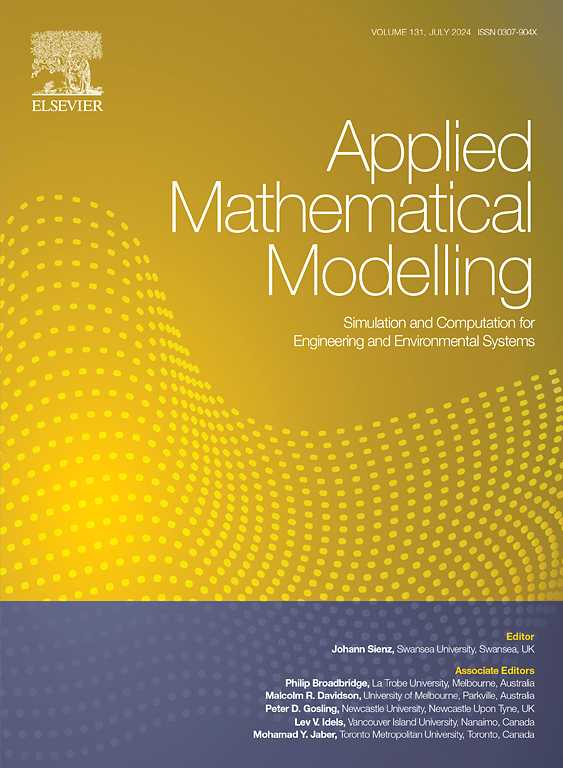Innovative data-driven algorithm for defect parameter identification in large-scale structures
IF 4.4
2区 工程技术
Q1 ENGINEERING, MULTIDISCIPLINARY
引用次数: 0
Abstract
This study proposes an innovative data-driven algorithm that combines the scaled boundary finite element method with an autoencoder and a causal dilated convolutional neural network for defect identification in large-scale structures. The scaled boundary finite element method simulates the propagation of waves in large-scale structures containing various types of defects. Conveniently, the scaled boundary finite element method can simulate different types of defects within structures and, by discretizing only the boundaries of structures, efficiently generate sufficient training data. To simulate wave propagation in large-scale structures, an absorbing boundary model based on Rayleigh damping is established, avoiding computations across the entire structural domain. The affinity propagation clustering algorithm is employed to optimize the number and layout of sensors, and the optimized multi-sensor data serve as the original training samples for autoencoder feature extraction. Autoencoder exhibits strong nonlinear feature extraction capabilities, mapping the high-dimensional original input feature vector space to a low-dimensional latent feature vector space to obtain low-dimensional latent features for network model training. This effectively improves the learning efficiency of the network model. The constructed causal dilated convolutional neural network model ensures orderliness of temporal data and achieves a larger receptive field without increasing neural network complexity, thereby capturing more historical information. Numerical examples demonstrate that the proposed model can accurately identify the quantified information of defects in large-scale structures. Compared with the previous model, the proposed model exhibits improved robustness.
大型结构缺陷参数识别的创新数据驱动算法
本研究提出了一种创新的数据驱动算法,该算法将尺度边界有限元法与自编码器和因果扩展卷积神经网络相结合,用于大规模结构的缺陷识别。尺度边界有限元法模拟了波在含多种缺陷的大尺度结构中的传播。比例边界有限元法可以方便地模拟结构内部不同类型的缺陷,并且只对结构的边界进行离散化,可以有效地生成足够的训练数据。为了模拟波在大尺度结构中的传播,建立了基于瑞利阻尼的吸收边界模型,避免了整个结构域的计算。采用亲和传播聚类算法对传感器数量和布局进行优化,优化后的多传感器数据作为自编码器特征提取的原始训练样本。Autoencoder具有较强的非线性特征提取能力,将高维原始输入特征向量空间映射到低维潜在特征向量空间,获得用于网络模型训练的低维潜在特征。这有效地提高了网络模型的学习效率。所构建的因果扩展卷积神经网络模型保证了时间数据的有序性,在不增加神经网络复杂性的情况下实现了更大的接受场,从而捕获了更多的历史信息。数值算例表明,该模型能准确识别大尺度结构中缺陷的量化信息。与之前的模型相比,该模型具有更好的鲁棒性。
本文章由计算机程序翻译,如有差异,请以英文原文为准。
求助全文
约1分钟内获得全文
求助全文
来源期刊

Applied Mathematical Modelling
数学-工程:综合
CiteScore
9.80
自引率
8.00%
发文量
508
审稿时长
43 days
期刊介绍:
Applied Mathematical Modelling focuses on research related to the mathematical modelling of engineering and environmental processes, manufacturing, and industrial systems. A significant emerging area of research activity involves multiphysics processes, and contributions in this area are particularly encouraged.
This influential publication covers a wide spectrum of subjects including heat transfer, fluid mechanics, CFD, and transport phenomena; solid mechanics and mechanics of metals; electromagnets and MHD; reliability modelling and system optimization; finite volume, finite element, and boundary element procedures; modelling of inventory, industrial, manufacturing and logistics systems for viable decision making; civil engineering systems and structures; mineral and energy resources; relevant software engineering issues associated with CAD and CAE; and materials and metallurgical engineering.
Applied Mathematical Modelling is primarily interested in papers developing increased insights into real-world problems through novel mathematical modelling, novel applications or a combination of these. Papers employing existing numerical techniques must demonstrate sufficient novelty in the solution of practical problems. Papers on fuzzy logic in decision-making or purely financial mathematics are normally not considered. Research on fractional differential equations, bifurcation, and numerical methods needs to include practical examples. Population dynamics must solve realistic scenarios. Papers in the area of logistics and business modelling should demonstrate meaningful managerial insight. Submissions with no real-world application will not be considered.
 求助内容:
求助内容: 应助结果提醒方式:
应助结果提醒方式:


